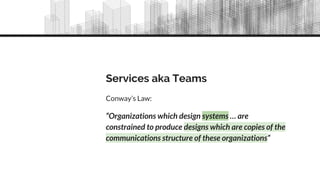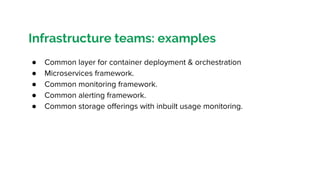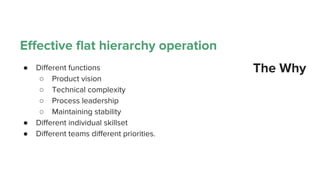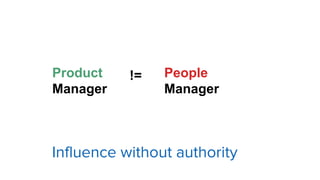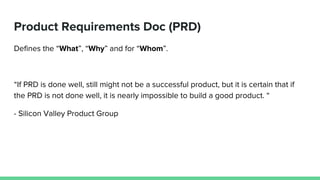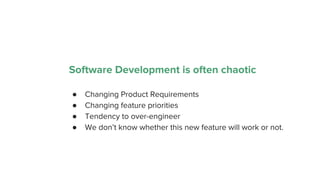Managing software projects & teams effectively
- 2. Team Structure Effective Process Product Lifecycle
- 4. Services aka Teams Conway’s Law: “Organizations which design systems … are constrained to produce designs which are copies of the communications structure of these organizations”
- 5. Company Product A Product B Frontend BHorizontal FunctionsFrontend A Backend A Backend B ● Functional vs Horizontal Teams ● Structure of a team
- 7. Functional teams ● Goal: agility. ● Services are product specific ● Responsible for both frontend & backend services. ● Connect with backend infrastructure services to do heavy lifting.
- 8. Infrastructure Teams ● Goal: stability. ● Functional -> Product Infrastructure -> Core infrastructure ● Each service is used by variety of clients. ● Pre-contracted SLA contract: QPS, performance ● Company-wide / Product-wide impact.
- 9. Infrastructure teams: examples ● Common layer for container deployment & orchestration ● Microservices framework. ● Common monitoring framework. ● Common alerting framework. ● Common storage offerings with inbuilt usage monitoring.
- 12. Structure of a (Productive) Team
- 13. Bottom-up (mostly) ● People come up with ideas ● Pitch ideas / prototype ○ To fellow engineers, managers ○ To leadership, customers ● Gain momentum. Move fast. Move faster. ● It’s like running a startup The Why
- 14. The Why Effective flat hierarchy operation ● Different functions ○ Product vision ○ Technical complexity ○ Process leadership ○ Maintaining stability ● Different individual skillset ● Different teams different priorities.
- 15. 4 key players ● Product manager ● Technical Lead (TL) ● Program Manager ● SRE The What
- 16. Product Manager ● Provides direction & vision for the product ● mini-CEO for the product ● Works with TLs/UX to define detail specifics ● Works with Sales, Marketing for go-to-market strategy “It is like being the Conductor of an orchestra”
- 18. Strategy is the key role, but PMs are the necessary glue for everything else.
- 19. Product Manager != People Manager Influence without authority
- 21. Technical Lead a.k.a TL ● Provides technical direction ○ Getting the technical architecture right ○ Negotiating product specs with PMs ● Responsible for keeping eng-team productive ○ Coordinates sub-tasks within team ● Main point-of-contact with external teams ● Not a manager, and has no reports usually
- 23. Contribution styles Technical complexity (my code, my algos) Leadership (my team x 10) Impact (my company) From Junior SWE to TL
- 24. Program Manager ● Provides structure to big projects ● Influence spans multiple teams ● Manage plans, schedules and drive deployment of projects ● Proficient in technical details and organizational skills ● Influence authority through processes and structure
- 25. Site-Reliability-Engineer (SRE) ● Responsible for keeping downtimes low (add another 9) ● Responsible for building and maintaining large scale production services ● Responsible for capacity planning ● Not all teams have SREs - they have to earn the traffic to have one.
- 26. SREs optimize for uptime, not for egos of individual teams / people
- 27. Product Manager Product Sense Technical Lead Technical complexity SRE Maintaining stability Program Manager Process Leadership
- 28. People Managers What do they do ? ● Coach. Help people achieve their individual goals ● Well-being & employee success. Finding the right team-fit. ● Collate feedback from a person’s peers. ● Resolve interpersonal issues. Who are they ? ● Sometimes TLs are TLM (TL + Manager) ● Part of a larger team, but not responsible for product decisions
- 29. Life of a Product
- 30. One good product, and many many bad products “ … no good product-market fit” “ … there were too many things changing. In the end, the backend architecture was a mess:. “ … it was too bloated. Maintenance hazard” “ … too much coordination was required across different teams”.
- 31. It’s worthwhile thinking about each part Propose Plan Execute Maintain. Refactor. Deprecate
- 32. Double Diamond: Strategy + Execution of the right solutioin
- 33. Propose. Propose Plan Execute Maintain. Refactor. Deprecate Step 1: PM / TL have an idea Step 2: Create a short Product-requirement document (few paragraphs) and circulate it quickly among team(s). Step 3: Discuss & iterate. Output - Vision Document - Product Requirements Document
- 34. Plan. Propose Plan Execute Maintain. Refactor. Deprecate Step 4: Technical design / architecture proposal Step 5: Circulate it among your own team first. Step 6: Resolve feedback, rinse repeat. Step 7: Circulate the design doc with other impacted teams Step 8: Define milestones and respective scopes, Two special milestones - “dogfood” and “launch” Output - Technical design doc with full detail - Milestones & Dependency plan
- 35. Execute. Propose Plan Execute Maintain. Refactor. Deprecate Step 9: Code, Code, Code. Daily / Bi-weekly standups until milestones. Step 10: Dark Launch (feature / product only enabled for the team) Step 11: Company dogfood launch Step 12: Public Launch Output - Product - Emergency playbook
- 36. Maintain. Refactor. Step 13: Discover bugs. Fix bugs. Push regularly. Step 14: More teams want to launch similar stuff. They want to reuse some components. Refactoring galore ! Fun fact: Google code changes about 50% in a year. Output - Stable Product - Reusable infrastructure
- 37. Deprecate. Propose Plan Execute Maintain. Refactor. Deprecate Step 15: Some more generic infrastructure components are identified and new backend created. Step 16: Slice of traffic is sent to new backend to try it out. Step 17: New backend is stable. Traffic to old backend is turned off. Step 18: Old backend is turned off and deleted if no one is using it. Output - Stronger, Faster, Higher
- 38. Product Requirements Doc (PRD) Defines the “What”, “Why” and for “Whom”. “If PRD is done well, still might not be a successful product, but it is certain that if the PRD is not done well, it is nearly impossible to build a good product. “ - Silicon Valley Product Group
- 39. Technical Design Doc (by Malte Ubl, Tech Lead Google AMP Project) Goals ● Document the software design. ● Clarify the problem being solved. ● Act as discussion platform to further refine the design. ● Explain the reasoning behind those decisions and tradeoffs made. ● List alternative designs and why they were not chosen. ● Support future maintainers and other interested parties to understand the original design. Non-goals ● Establish non-technical requirements of the software. ● Be independently understandable by a person with no background in software stack. ● Act as user documentation for product or system.
- 40. The Chromium projects (Design Docs) http://dev.chromium.org/developers/design-documents http://aosabook.org/en/posa/high-performance-networking-in-chrome.html
- 41. Oncall Playbooks “Hope is not a strategy.” ● Note down past failures, ○ What went wrong ○ What was the immediate fix ○ What is the long term fix ○ How to prevent it in future. ● Avoiding culture of “heros”
- 43. Everything is process ... Whether you’re compiling code, hiring staff, or making breakfast. - Andy Grove, High Output Management
- 44. Software Development is often chaotic ● Changing Product Requirements ● Changing feature priorities ● Tendency to over-engineer ● We don’t know whether this new feature will work or not.
- 45. Role of a process, is to improve effective productivity of the overall team towards the goal.
- 46. Examples Requirements gathering, build better products Planning & estimation, unwrangle dependencies Agile development, reduce engineering waste Triage, reduce backlog Launch checklist, follow best-practices Infrastructure Integration Process, communicate requirements
- 47. Process in various stages of product
- 49. Ruthlessly measure progress ● Define milestones ○ Date - Monthly / quaterly ○ Features / items in scope ● Define progress ○ What metrics ○ Define levels of achievement ■ Red = Below Expectations ■ Yellow = Meets expectations ■ Green = Stretch Goal ● Product launch is just one of the milestones Old adage - what you can measure, is what you can improve.
- 50. OKRs Objectives & Key Results
- 51. Iterations ● Unit of time for progress check ● 2 week to 1 month long ● Priorities should remain constant within a sprint ● Execution style: agile vs waterfall From one sprint to next, specs might change, priorities might change. Minimize throw away work. Software time estimation is hard. Iterations help manage estimation risk.
- 52. (Over) Communicate ● Not just about informing stakeholders ● What is working, what is not. ● What is pending, what is not. ● What is working amazing, what needs more work. Most engineers, what to work independently, and later emerge with their masterpiece. In practice, results in wasted efforts, and missing corner cases.
- 53. Retrospective “I think, we should cancel that weekly sync, there is no use for it”. “We should write a script for that. We get too many bugs doing that manually”. “If we launch this hack, it would help us launch and iterate.” Remember - Goal of a process is to add efficiency for the overall team towards the goal.
- 54. Minimize Waste Obviate unnecessary artifacts ● Pretty docs ● Over documentation ● Status meetings ● Lengthy launch approvals
- 55. Prioritized backlog ● Milestone planning leads to backlog ● Features / Bugs that were P0 before, may be P2 in later milestones. ● Careful management of backlog helps manage technical debt Dashboards ● Openness is the key ○ Bugs burn rates ○ Who’s working on what




